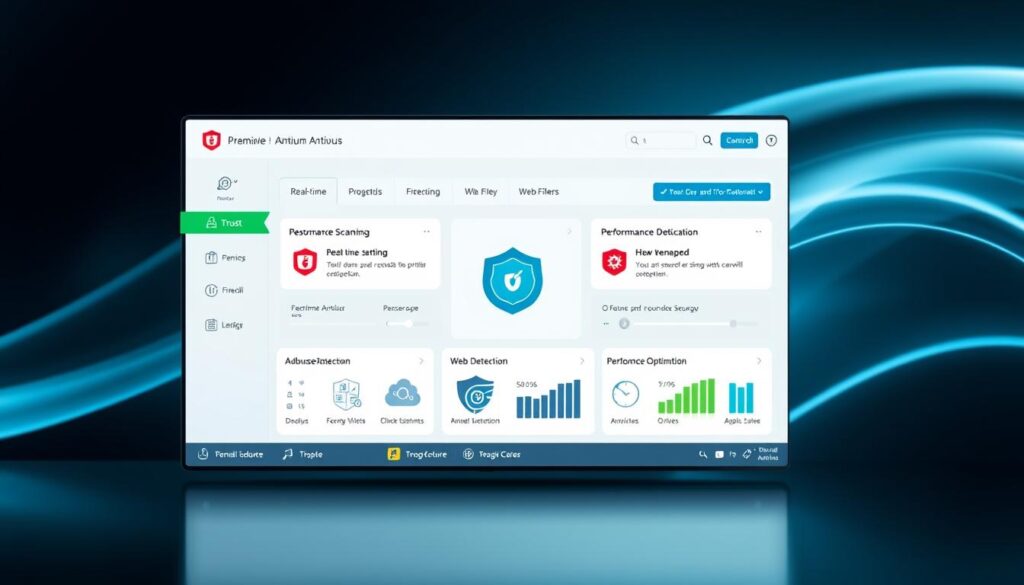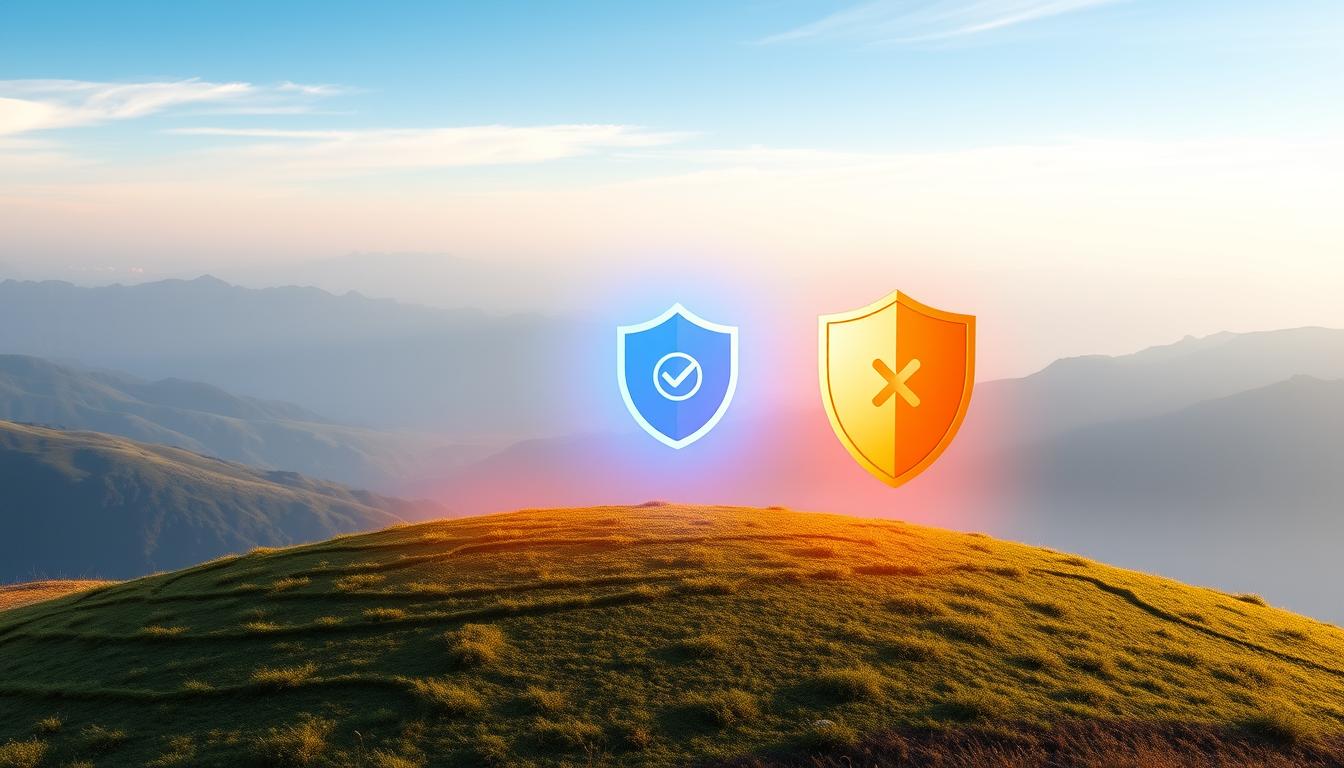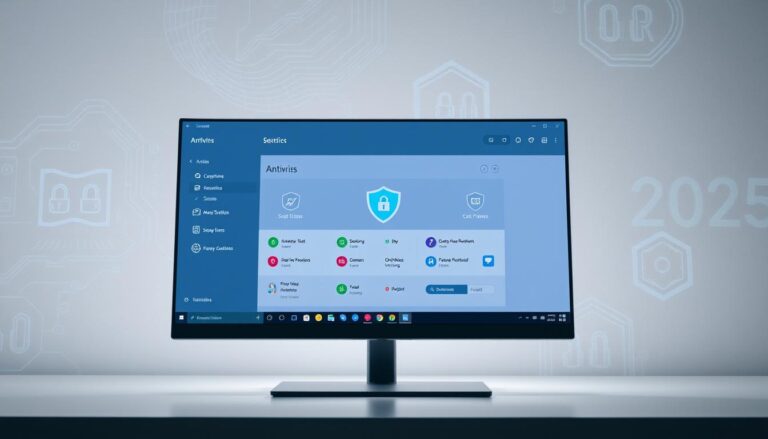Free vs Paid Antivirus: Which is Worth It?
Choosing the right antivirus software shapes how well your devices resist malware, ransomware, phishing, and other digital threats.
The comparison sets the scope: basic tools offer on-demand scans and visibility into known threats, while paid versions add real-time, proactive defenses that stop attacks before they land.
Small and midsize businesses and home users face higher risk as attackers expect weaker setups. That makes the decision a clear trade-off between convenience, cost, and real-world protection.
We’ll outline how antivirus software works, map the feature gap between free and paid solutions, and use examples like Malwarebytes to show differences in scanning, real-time blocks, and support.
Expect a neutral, practical review that highlights limitations of free antivirus software—ads, upsells, limited support—and the added value of paid antivirus versions, such as warranties and remediation help for SMBs.
Key Takeaways
- Basic options give baseline scanning and threat visibility.
- Paid solutions add real-time, proactive protection and wider coverage.
- SMBs face higher risk from ransomware and phishing attacks.
- Examples (e.g., Malwarebytes) show clear feature and support gaps.
- Consider cost, support, and long-term risk when choosing a version.
Understanding Antivirus Software and Today’s Threat Landscape
Antivirus software acts as a constant guard, scanning files, downloads, and web activity to spot threats before they harm your system.
What protection does this layer provide?
Core engines match known viruses and malicious patterns, then quarantine or remove infected files. Some tools can undo changes made by malware and remove tracking components like keyloggers.
Beyond signature checks, many suites flag unsafe websites, warn about suspicious links, and block harmful app installs. These functions help keep a single device or an entire home network safer.
Why present threats demand more than basic protection
Attackers use phishing pages and ransomware that can encrypt critical files and demand payment. Zero‑day exploits have no known signatures, so heuristic, behavioral, and AI/ML analysis help detect anomalies.
Mobile devices also face adware, malicious apps, and unsafe Wi‑Fi risks. As threats evolve, maintaining effective protection often requires updates and features that go beyond a bare‑bones, free setup.
- On‑demand scanning runs when you ask; real‑time protection watches continuously.
- Heuristic and behavioral tools catch unknown threats that signature lists miss.
- Comprehensive coverage should include web shields, ransomware guards, and privacy controls.
Free vs Paid Antivirus
Not all protection behaves the same. Some tools scan and clean after an infection. Others try to stop attacks before they run.
Baseline features you can expect from free antivirus software
Basic products handle malware detection and removal, offer scheduled or manual scans, and warn about suspicious websites. They can restore a computer after common infections and sometimes spot unknown devices on a home network.
Depth of protection and proactive defenses
Paid antivirus software often adds continuous, real-time monitoring, AI/ML threat detection, and layered shields for ransomware and phishing. These paid versions aim for prevention rather than only cleanup.
Reactive versus proactive models
Free versions tend to rely on signatures and react after compromise. A paid product emphasizes proactive prevention and threat isolation to reduce impact.
Privacy trade-offs and support
Many no-cost apps show ads and collect telemetry to fund development. In contrast, paid antivirus offerings usually include live remediation, 24/7 support, and sometimes warranties that help recover from more serious attacks.
- Quick summary: free covers basics; paid adds active shields and expert help.
Risks and Limitations of Free Antivirus Software
Many no-cost security packages leave important detection gaps that attackers quickly exploit.
Signature-based detection powers a lot of at‑no‑cost software. This approach flags known viruses but struggles with zero‑day exploits and novel threats. That delay widens the window where files and systems remain vulnerable.
Gaps against unknown or yet‑known threats
Without strong behavioral and heuristic engines, some tools miss fileless attacks and lateral movement. Hackers use subtle persistence tactics that basic protection may not notice until damage appears.
Limited or no customer support and remediation
Free tiers typically offer FAQs and community forums, not live remediation. During an active incident, lack of hands‑on help can extend downtime and increase recovery costs.
Licensing and terms: personal use vs. small business use
Many free product licenses restrict commercial use. Small businesses using consumer-grade software may void guarantees and lack warranties when breaches occur.
Adware, bundled components, and impostors
Some free apps bundle extra software or display persistent upgrade prompts that degrade the user experience. Worse, counterfeit offerings can carry adware or spyware, adding new risks instead of reducing them.
- Tip: Vet vendors, download from official sites, and weigh the true cost of lost data before choosing no‑cost tools.
Benefits of Paid Antivirus and Premium Security Features
Premium security tiers add layers designed to stop threats before they reach your files. Paid solutions bring active defenses and management tools that improve protection across computers and other devices.

Advanced detection and threat shields
AI/ML engines look for suspicious behavior, not just known signatures, so unknown malware and zero‑day attacks can be blocked before execution.
Ransomware shields and phishing site detection add extra barriers that limit what hackers can do once they try to intrude.
Device and data safeguards
Premium suites often include webcam control, remote access blocking, and secure file shredding to protect privacy and permanently remove sensitive files.
Operational resilience and control
Automatic app and engine updates close common vulnerabilities on the system and keep protection current across multiple endpoints.
Configuration control and policy management help keep settings consistent for home offices or small business networks.
Support, remediation, and guarantees
24/7 support and live remediation reduce downtime by containing active incidents and guiding a full recovery. Some vendors also back their product with warranties or guarantees to clarify recourse.
Entry pricing often starts near $39.99/year for basic premium tiers; review software offers and bundles to match features and budget.
- Summary: paid antivirus software expands detection, adds layered protection, and delivers support and management tools that help defend devices and files.
Key Factors to Consider Before You Choose
Picking the right security option means matching costs, features, and the likely impact of a breach on your operations. Think beyond sticker price and focus on long‑term risk to data, downtime, and reputation.
Budget and total cost versus breach risk
Balance subscription fees against potential breach costs, including recovery, regulatory fines, and lost customers.
Cyber insurance may require specific capabilities or paid solutions to keep coverage valid.
Feature fit: protection, security features, and device coverage
Confirm the product supports your environment: Windows, macOS, Android, and iOS if needed.
Look for real‑time shields, phishing and ransomware defenses, and compatibility with apps you run.
Support expectations: deployment, operations, and incident response
Verify 24/7 support and whether live remediation is included during active attacks.
Assess management features if you must administer multiple devices or endpoints.
Product reviews, analyst ratings, and vendor reputation
Prioritize vendors with recent, credible evaluations. Watch for caveats that affect SMBs.
Ads, upsells, and bundled software considerations
Check licensing carefully. Many low‑cost tiers limit commercial use and rely on ads or telemetry.
- Avoid bundles that add adware or reduce performance.
- Confirm software offers and support terms before you commit.
Example Snapshot: Free vs Paid Protection in Practice
This snapshot uses Malwarebytes to show how a manual scanner compares to always‑on shields.
Scanning and real‑time protection differences
Malwarebytes Free provides user‑initiated scanning on Windows and macOS. That means a scan runs only when someone starts it.
The paid version adds continuous, real‑time scanning and removal. That ongoing guard can stop threats before they do damage to the system.
Ransomware, phishing, and malicious website blocking
Premium tiers add ransomware and phishing shields. These reduce successful attacks on a computer and its data.
Paid protection also blocks malicious websites and zero‑day exploits that manual scans can miss.

Browser guards and additional controls
Browser Guard blocks trackers, cryptojackers, and known bad domains at the browser level. Mobile protections vary: Android gets adware detection and privacy audits; iOS benefits from ad blocking and SMS filtering.
Premium adds brute‑force and uninstall protection to make persistence harder for hackers.
| Feature | Free version | Paid version |
|---|---|---|
| On‑demand scanning | Yes | Yes |
| Real‑time protection | No | Yes |
| Ransomware & phishing shields | No | Yes |
| Browser guard & tracker blocking | Limited | Full |
| Annual pricing (approx.) | 0 | $39.99 |
Bottom line: manual scans help clean up infections, but always‑on tools and browser guards change outcomes by stopping many threats at entry. That difference is the key trade‑off when you weigh cost against risk.
Who Should Choose Free, and Who Needs Paid Solutions?
Your environment and the value of your data should guide whether you pick a simple or a comprehensive option.
Home users and students seeking basic protection
Home users and students with low exposure can accept a lighter option that offers on‑demand scans and web warnings.
Choose this path if you store little sensitive data, run manual scans regularly, and can tolerate ads or limited support.
Small and midsize businesses needing robust, multi‑device security
SMBs face targeted attacks and higher recovery costs. Paid antivirus solutions give centralized controls, multi‑OS coverage, and proactive defenses.
Look for ransomware shields, phishing protection, and 24/7 support to keep operations running and reduce downtime.
Regulated industries and data‑sensitive organizations
If compliance, audits, or customer data are involved, paid solutions are the safer option.
They provide logging, device control, and service-level support that help meet regulatory requirements and protect critical data.
Multi‑device households across Windows, macOS, Android, and iOS
Families with many devices benefit from a single paid plan that enforces consistent rules and simplifies updates.
This approach reduces configuration drift and ensures every device receives the same level of protection and control.
- Recommend a basic option for low‑risk personal users who can manage manual scans and accept limited support.
- Advise SMBs and regulated groups to adopt paid solutions with multi‑device coverage and centralized control.
- Note that licensing for no‑cost editions usually excludes business use, so choose paid software for commercial activity.
- Consider future growth—scalable paid plans prevent costly migrations later.
| Use case | Best option | Key benefits |
|---|---|---|
| Students / casual users | Basic/no‑cost option | On‑demand scans, low cost, simple setup |
| Small & midsize businesses | Paid solutions | Multi‑device coverage, centralized control, proactive defense |
| Regulated / data‑sensitive | Paid solutions | Audit logs, strong phishing and ransomware protection, support |
| Multi‑device households | Paid solutions | Cross‑platform coverage, uniform policies, easier management |
Conclusion
Choosing the right protection comes down to risk, device count, and support needs. For many users, basic, no‑cost options offer baseline scanning against known malware and viruses. But that only covers part of today’s threat landscape.
Paid solutions add real‑time prevention, phishing and ransomware shields, device privacy controls, and dependable support that reduce downtime when attacks happen. Practical examples like Malwarebytes show how on‑demand scans differ from always‑on guards and browser defenses.
Match the product to your environment: a simple free version may work briefly for low‑risk personal use, while households, SMBs, and regulated teams benefit from layered security and service. Compare features, verify licensing, and weigh total cost of ownership against the impact of a breach.
Pick reputable vendors, keep software updated across all devices, and choose the version that best fits your data and operational needs.
FAQ
What does antivirus software do on my devices?
Antivirus tools scan files and apps for known malware signatures, monitor system activity for suspicious behavior, block malicious websites, and remove detected threats. Modern products add layers like heuristic analysis, machine learning, and behavior monitoring to detect unknown attacks before they execute. They also help manage updates and patching to reduce exposure to exploits.
Why do today’s threats need more than basic protection?
Attackers use ransomware, fileless malware, supply‑chain compromises, and social engineering that can bypass signature‑only defenses. Basic scanners may miss zero‑day exploits and sophisticated phishing campaigns. Enhanced defenses—real‑time heuristics, sandboxing, and web filtering—reduce the chance of successful intrusions and data loss.
What baseline features are usually included with free security tools?
Entry‑level editions typically offer on‑demand scanning, basic real‑time protection, and browser protection for common threats. They may include limited firewall integration or quarantine functions but often lack advanced features like ransomware shields, secure VPNs, or parental controls.
How do proactive defenses differ from reactive approaches?
Reactive tools detect and remove known threats after infection, relying on signature updates. Proactive defenses use behavior analysis, heuristics, and machine learning to identify suspicious actions before damage occurs. Proactive models also include exploit mitigation and rollback capabilities for ransomware recovery.
Are there privacy trade‑offs with free versions?
Many no‑cost editions display ads, promote paid upgrades, or collect telemetry to fund development. Some vendors may share anonymized usage data with partners. If privacy is a priority, review the vendor’s data handling policies and consider paid plans that limit tracking and include stronger privacy controls.
What support and remediation can I expect from free versus paid products?
Free options usually offer community forums or email support with slow response times. Paid tiers commonly include 24/7 live chat or phone support, guided malware removal, and in some cases financial guarantees or identity‑theft remediation services.
What gaps exist in no‑cost security tools against unknown threats?
Free editions often lack advanced heuristics, cloud‑based threat intelligence, sandbox analysis, and automatic rollback after ransomware. These gaps reduce effectiveness against new attack vectors and advanced persistent threats that require layered detection strategies.
Can I use free software for business or commercial purposes?
Licensing varies by vendor. Many no‑cost licenses are restricted to personal use only and explicitly prohibit commercial deployment. Small businesses should verify terms or opt for business plans that include multi‑device management and compliance features.
Are there risks of adware or bundled components in free downloads?
Some free installers include optional toolbars or promotional offers, which can degrade performance or collect extra data. Always download from the vendor’s official site, opt out of extras during install, and review bundled elements before accepting them.
What advanced protections do paid security suites provide?
Premium suites add ransomware protection, phishing and malicious‑site blocking, advanced firewall rules, exploit mitigation, machine‑learning detection, secure VPNs, password managers, and device control features like webcam and microphone protection.
How do paid features protect device and data safety specifically?
Paid features often include file encryption, secure file deletion (shredding), remote device locking/wiping for lost phones, and controls that block unauthorized access to peripherals. These functions reduce risk of data exposure and unauthorized remote control.
What role does 24/7 support and remediation play in paid plans?
Around‑the‑clock support helps with urgent incidents—live guidance to remove malware, restore systems, or coordinate recovery. Many vendors also offer incident guarantees or remediation services that speed recovery and minimize downtime.
How should I weigh budget against breach risk?
Consider the value of your data, potential downtime costs, and regulatory exposure. For casual web use, lower‑cost options may suffice. For business use or valuable personal data, investing in stronger protections and reliable support often reduces long‑term risk and costs from breaches.
Which features should I prioritize when choosing protection?
Prioritize real‑time threat detection, ransomware defense, web and email protections, multi‑device coverage, and strong vendor reputation. Match feature sets to your device mix—Windows, macOS, Android, iOS—and the sensitivity of stored data.
How much should I trust product reviews and vendor ratings?
Use independent test lab results (AV‑Comparatives, AV‑TEST, SE Labs) and multiple professional reviews to verify detection rates, false‑positive performance, and impact on system resources. Also check recent user feedback for support quality and update cadence.
Do paid suites include protections like browser guards and phishing filters?
Yes. Premium versions commonly provide browser extensions or built‑in web filters that block malicious URLs, prevent credential theft, and warn about unsafe downloads. These layers significantly reduce successful phishing and drive‑by attacks.
Who should consider a basic, no‑cost option?
Individuals with minimal exposure—limited device use, cautious browsing habits, and data of low sensitivity—may be fine with entry‑level tools supplemented by safe practices, regular backups, and OS updates.
Who needs a paid, full‑featured security solution?
Small businesses, remote workers handling sensitive customer data, regulated organizations, and multi‑device households should choose comprehensive protection with centralized management, stronger detection, and professional support to reduce breach and compliance risks.
How do I compare products in practice, for example scanning and real‑time protection?
Test performance metrics from independent labs and trial hands‑on versions. Look for low system impact, fast scan times, high detection rates, and effective real‑time blocking. Compare vendors like Microsoft Defender, Malwarebytes, Norton, Bitdefender, and Kaspersky for feature balance and pricing.
What should I do after a suspected infection if I only use a basic tool?
Disconnect the device from networks, run a full system scan, boot into safe mode if needed, and back up crucial files before attempting remediation. If removal fails, seek paid professional help or use a trusted recovery tool from a reputable vendor.







